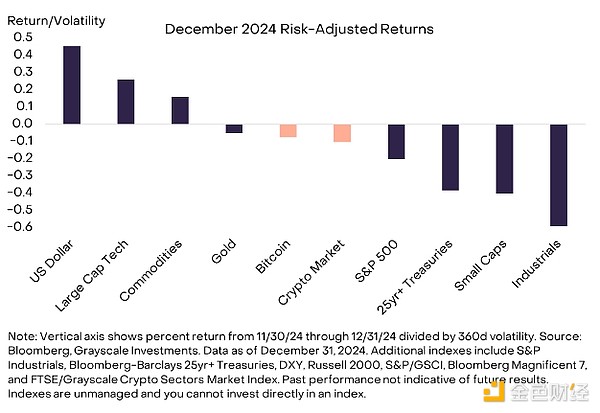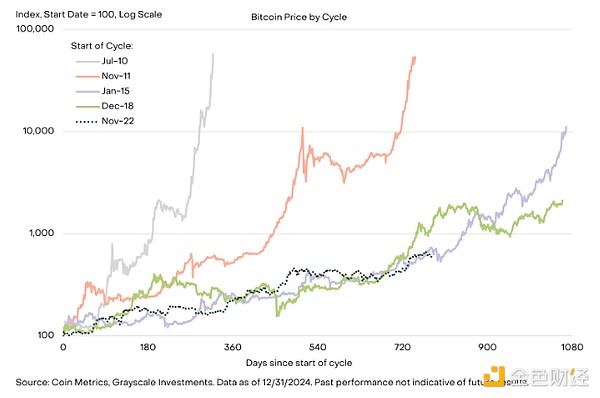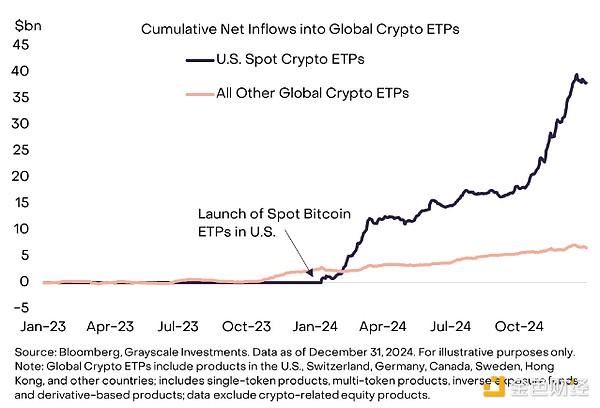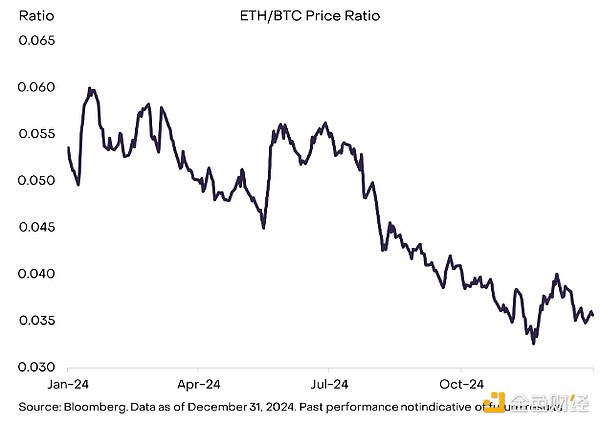Source: Grayscale; Compiled by: Deng Tong, Golden Finance
Summary
Crypto valuations fell in December after rising at the beginning of the year. The pullback may reflect a more hawkish signal from the Federal Reserve. Both recent Bitcoin bull runs saw declines of similar magnitude.
Spot Bitcoin and Ethereum exchange-traded products (ETPs) were launched in the U.S. market in 2024. Cumulative inflows have now reached $38 billion. [1] Bitcoin and Ethereum fell 3% and 10% respectively that month. [2]
The financial cryptocurrency sector performed well in December. Grayscale Research believes that this segment may benefit from regulatory changes and/or new legislation from the incoming U.S. government and has listed several decentralized finance (DeFi)-related assets in its updated Top 20 list. The top 20 also lists assets related to decentralized AI technology, which remains a focus of market attention.
In early January, the Senate will consider President-elect Trump’s nominees for Treasury Secretary, Commerce Secretary, SEC Chairman, and CFTC Chairman.
In December 2024, the cryptocurrency market took a breather, with major stock indices retreating and bond yields rising. Grayscale Research attributes many of the market changes to the more hawkish signals from the Federal Reserve at its mid-December meeting. Despite the setback last month, Bitcoin was still up 121% at the end of 2024. [3]
Traditional markets had a mixed year-end performance (Figure 1). The U.S. dollar rose in December and interest rates across the yield curve rose. Guidance from the Federal Reserve to slow the pace of rate cuts in 2025 may have contributed to the moves in currency and bond markets. Broad-cap indices fell, led by cyclical market sectors. Large-cap technology stocks (represented by the Bloomberg Seven Index) were the exception, rising in December and posting strong returns for the year. Bitcoin fell slightly, with risk-adjusted (i.e., taking into account the volatility of each asset) returns in the middle of the pack. The FTSE/Grayscale Cryptocurrency Sector Market Index (CSMI) fell 6% in December, giving up about 15% of its gains since November 2024.
Figure 1: Risk-adjusted cryptocurrency returns are middling

Short-term declines are a common feature of cryptocurrency bull markets.For example, during the latest appreciation phase of the cryptocurrency market cycle (from December 2018 to November 2021), the price of Bitcoin increased by about 21 times. However, during this period, the price of Bitcoin fell by at least 10% a total of 11 times, including two large declines of about 50%. During the previous appreciation phase of the cryptocurrency market cycle (from January 2015 to December 2017), the price of Bitcoin fell by at least 20% a total of 11 times. [4] We continue to believe that we are in the middle of the current Bitcoin bull run, with further upside potential to 2025 and beyond as long as the market remains supported by fundamentals (Exhibit 2).
Figure 2: Bitcoin price trend before the two bull runs

In December, spot Bitcoin exchange-traded products (ETPs) listed in the United States once again became an important source of new demand, with net inflows totaling $4.7 billion that month. Including the spot Ethereum ETP launched in July, the total cumulative net inflows of spot cryptocurrency ETPs listed in the United States have now reached $38 billion. [5] While cryptocurrency ETPs in other jurisdictions have also seen increased investor demand, the cumulative inflows have been lower and more stable from month to month (Figure 3).
Figure 3: U.S.-listed spot cryptocurrency ETPs see surge in demand

Another important source of demand for Bitcoin in the U.S. market is MicroStrategy, a publicly traded company that holds Bitcoin on its balance sheet and operates primarily as a Bitcoin investment vehicle. [6] MicroStrategy was included in the Nasdaq 100 Index in December. [7] MicroStrategy purchased 194,180 bitcoins in Q4 2024, with a year-end market cap of $18.2 billion. [8] As such, MicroStrategy’s purchases of bitcoin in Q4 were comparable to net inflows into spot Bitcoin ETPs in Q4. [9] MicroStrategy issued equity and debt instruments to fund its bitcoin purchases, and has announced plans to continue purchasing bitcoin over the next three years. [10] Given the quantitative importance of this source of bitcoin demand, cryptocurrency investors should consider monitoring MicroStrategy’s financial performance metrics, including the difference between the company’s market cap and the value of its bitcoin holdings. Generally speaking, if a company’s shares are trading at a premium to the value of its bitcoin, it may be incentivized to issue shares and purchase more bitcoin.
In December, Ethereum (ETH) underperformed Bitcoin (BTC), with the ETH/BTC price ratio moving sideways over the past two months (Figure 4). Ethereum is the leading smart contract platform blockchain by market cap, but it faces increasing competition from other projects. [11] Ethereum underperforms Solana, the second-largest asset by market cap, in 2024, [12] and investors are increasingly interested in alternative layer 1 networks such as Sui and The Open Network (TON). When creating infrastructure for application developers, architects of smart contract blockchains face a variety of design choices that can impact technical characteristics such as block times, transaction throughput, and average transaction fees. Regardless of the specific design choices, all smart contract platforms compete for network fee revenue, which Grayscale Research believes is an important determinant of value accumulation.
Figure 4: Ethereum underperforms Bitcoin in December and throughout 2024

Grayscale’s cryptocurrency industry framework shows that digital asset valuations generally retreated in December (Figure 5). The worst performing market segment was the consumer and cultural cryptocurrency sector, mainly due to the decline in the price of Dogecoin, the largest meme coin by market capitalization. [13] One exception to the broader market decline was the financial cryptocurrency sector, which was primarily supported by gains in Binance Coin (BNB), the token associated with the Binance exchange and the Binance Smart Chain smart contract platform. Grayscale Research believes that regulatory changes and new legislation from the new U.S. administration could be particularly supportive of blockchain-based financial applications. As a result, we feature several decentralized finance (DeFi)-related assets in our latest Top 20 list.
Figure 5: Financial crypto sector outperforms

New innovations related to decentralized AI technology were the dominant theme in the crypto market in 2024, and are likely to be the dominant theme again in the new year. Much of the attention remains focused on developments related to AI “agents”—software that can act independently to pursue a complex set of goals. These AI agents are revolutionizing how we interact with blockchain technology, as demonstrated by Luna on the Virtuals protocol. Luna is a female anime-style chatbot whose specific goal is to attract 100,000 followers on X, and notably, she can pay (“tip”) users in Luna tokens through their own crypto wallets to perform financial transactions. This integration with blockchain technology is particularly important because it enables AI agents like Luna to directly access and allocate financial resources, which goes beyond previous use cases for task-based agent AI.
Since the emergence of AI agent tokens in late October 2024, the industry’s leading projects by market cap have achieved extraordinary gains, with Virtual soaring 49,000% and Ai16z up 8,700%[14]. Notably, ai16z, a project named after the investment firm a16z, built the number one AI agent framework on GitHub[15] in December and announced a partnership with Stanford University. [16]
Finally, 2024 marks a landmark year for digital asset markets: new spot Bitcoin and Ethereum ETPs bring more investors to the crypto ecosystem, the Bitcoin network undergoes its fourth halving event, researchers make breakthroughs in new blockchain application technologies, and cryptocurrencies feature prominently in the U.S. election.While some specific themes will change, we expect 2025 to remain exciting for cryptocurrency investors.
In early January, the U.S. Senate will begin considering President-elect Trump’s nominees for Cabinet and heads of various government agencies. For the cryptocurrency market, we believe the most important confirmations are likely to be for Secretary of the Treasury (Scott Bessent), Secretary of Commerce (Howard Lutnick), Chairman of the Securities and Exchange Commission (SEC) (Paul Atkins), and Chairman of the Commodity Futures Trading Commission (CFTC) (no nominees have been announced at the time of this writing). The new role of White House AI and Crypto Czar (David Sacks) does not require Senate confirmation. While Grayscale Research expects the next Congress to pass cryptocurrency-related legislation, this may not occur until lawmakers resolve taxation and certain other issues. Outside the United States, the European Union’s MiCA regulation, which fully takes effect on December 30, 2024, imposes stricter rules on stablecoins, leading to Tether’s unlicensed USDT being delisted from exchanges starting in 2025 in favor of compliant alternatives such as Circle’s USDC. [17]
Beyond politics, cryptocurrency markets appear likely to be driven by their usual fundamentals: global adoption of Bitcoin as an alternative monetary medium, demand for the next generation of decentralized web applications, and macro market factors such as changes in central bank monetary policy that impact valuations of all assets. Despite the uncertain outlook, we believe that many industry trends look favorable at the start of the new year.
Index Definitions:
The Bloomberg Big Seven Total Return Index (BM7T) is an equal dollar-weighted index that tracks the seven most widely traded companies in the United States. The S&P 500 Industrial Index includes companies in the S&P 500 that are classified as members of the GICS Industrial sector. The Bloomberg-Barclays 25+ Year Treasury Bond Index measures the total return of nominal U.S. Treasury bonds with a remaining maturity of more than 25 years. The U.S. Dollar Index (DXY) tracks the strength of the U.S. dollar against a basket of major currencies. The Russell 2000 Index consists of the smallest 2000 companies in the Russell 3000 Index, representing approximately 8% of the total market capitalization of the Russell 3000. The S&P Goldman Sachs Commodity Index (S&P/GSCI) is a composite index of commodity sector returns, representing an unleveraged, long investment in commodity futures that is broadly diversified across a variety of commodities. The FTSE/Grayscale Crypto Sector Index Series measures the price returns of digital assets listed on major exchanges around the world. The Nasdaq 100 is a stock index of the 100 largest companies traded on the Nasdaq exchange, calculated by modified market capitalization.
References:
[1] Source: Bloomberg, Grayscale Investments. Data as of December 31, 2024.
[2] Source: Artemis. Data as of December 31, 2024.
[3] Source: Coin Metrics. Data as of December 31, 2024.
[4] Source: Coin Metrics. Grayscale Investments. Data as of December 31, 2024. Past performance is not indicative of future results.
[5] Source: Bloomberg, Grayscale Investments. Data as of December 31, 2024.
[6] Investopedia, data as of December 23, 2024. Michael Saylor “calls MicroStrategy a Bitcoin treasury firm.”
[7] Markets.com
[8] Source: Bitcointreasuries.net, Bloomberg, Grayscale Investments. Data as of December 31, 2024.
[9] Spot Bitcoin ETPs saw net inflows of $16.5 billion in Q4, based on value at time of inflows. ETPs’ Bitcoin holdings increased by $18.6 billion in Q4, based on year-end prices. Source: Bloomberg, Grayscale Investments. Data as of December 31, 2024.
[10] Microstrategy, as of January 3, 2025.
[11] Artemis, FTSE, Grayscale. As of January 6, 2025.
[12] Artemis, FTSE, Grayscale. As of January 6, 2025.
[13] Artemis, FTSE, Grayscale. As of January 6, 2025.
[14] Dexscreener. As of January 2, 2025
[15] Chain Catcher
[16] Blockworks
[17] EY, Currency Analysis
 Catherine
Catherine











